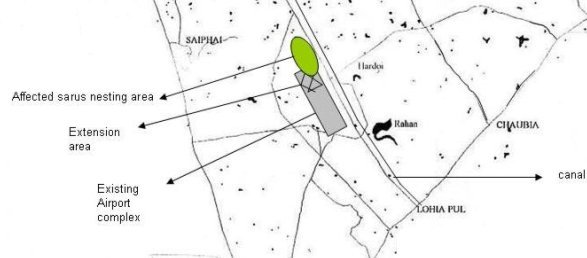The Sarus crane is the tallest of the cranes, standing six feet tall; it has a wingspan of eight feet. Of the different Sarus types, the Indian Sarus (Grus antigone antigone) is the only resident crane that breeds south of the Himalayas. The population of the Indian Sarus is distributed across the States of Haryana, Gujarat, Rajasthan, Maharashtra, Uttar Pradesh, and Madhya Pradesh. Nearly half of the Sarus cranes in India are in UP alone, according to a study by the Bombay Natural History Society, and the concentrations of the birds are highest in Mainpuri and Etawah districts of the state. These two districts alone, the study reports, have a population of 2500-3000 Sarus cranes, with the maximum being found around four wetlands; Kudaiyya, Ambarpur, Saman Katra and Sarsai Nawar. It is no surprise, therefore, then that the Sarus Crane is the state bird of Uttar Pradesh.

![]() Picture credit: Amlan Dutta
Picture credit: Amlan Dutta
The Sarus crane is currently listed in Schedule IV of the Wildlife (Protection) Act, 1972. It is also regarded internationally as a threatened species, and is proposed to be placed in the 'vulnerable' category in The World Conservation Union (IUCN) Red List. The Species is also listed in Appendix II of the CITES which is an international agreement between governments to ensure that international trade in specimens of wild animals and plants does not threaten their survival.
These protections have become important and contentious, due to the plans for expansion of an air strip near the village of Saifai, in Etawah. In May 2005 Mulayam Singh Yadav, the Chief Minister of Uttar Pradesh, made statements in the press clearly indicating the intentions behind the expansion. He said that with the air strip around Saifai village being expanded, the area's industrial potential should rise. Saifai is the CM's native village, and media reports have indicated that he wants to showcase it as the face of development in Uttar Pradesh. (click here, here, and here for examples)
The news reports sounded alarm bells for many who are concerned with the conservation of the wetlands, and in particular the Sarus crane's habitat. Taking a cue from the information in newspaper reports and pre-empting any possible danger that maybe caused to the wetlands, an application was filed by the Wildlife Trust of India against the Government of Uttar Pradesh before the Central Empowered Committee of the Supreme Court, a monitoring body established by the court in 2002 for a period of five years. The application seeks a stay on the expansion of the air strip. In the petition the applicant attempts to draw attention to the immediate threat to the crane's habitat, and highlights the fact that the construction of an air strip is bound to have a detrimental impact. This impact is likely to be caused due to the filling up of the wetlands as well as the resultant disturbances in the form of increased noise and air pollution, as well as from vehicular traffic.

The proposed extension of the airport would overlap the cranes' habitat.
(Map from survey carried out by WTI)
The application did not rely on newspaper reports alone; additionally, to understand the implications of the proposed expansion, the applicant undertook a survey of the region in November 2005. The survey team documented through photographic evidence that showed that the foundation stone had been laid and construction activity was being undertaken in areas frequented by the Sarus cranes. This evidence was included in the application. The petition also highlighted the fact that the wetlands in Mainpuri and Etawah are valuable treasure houses of faunal and floral diversity, and that the cranes were not the only focus of concern. The WTI argued that:
-
"... They have incredible historic value, and are recognized by national and international biologists as important stop-over sites for wintering birds."
-
"In addition to very large numbers of migrating birds visiting the area's wetlands in winter, the wetlands are home to hundreds of the severely endangered Black-necked Storks."
-
"The highest density of population of Sarus Cranes is inseparably associated with these wetlands. Almost 30% of the global population of the endangered crane is dependent on these wetlands."
-
"The wetlands are the only known substitute sites for the critically endangered Siberian cranes, which only visit the famed Keoladeo Ghana National Park at Bharatpur"

•
Chiru: A species in decline
•
Courser habitat under threat
•
Destination Siroy!
It is important to note that the threats to the Mainpuri and Etawah wetlands are not new. In 2002, the Wildlife Trust of India had filed a writ petition in the Allahbad High Court in view of the proposal of the Ministry of Agriculture to drain the area for creation of agricultural land. This was part of a World Bank-assisted scheme designed to give thousands of hectares of land, classified as 'wasteland', to farmers (click here and here for more). The order of the High Court in that litigation clearly stated that no activity or project that endangers the wetlands would be allowed. To quote,
" ... It appears that the state government has taken a serious note of and expressed concerns over the problems the writ petitioner raised in the writ petition. Sri Ashok Mehta, learned Chief Standing Counsel has also assured us that existing Nala drainage will be widened and no developmental activity adversely affecting the natural habitat of wildlife within these protected areas will be allowed .... it also appears from the report that a considerable area has been designated as Saman Bird Sanctuary in Mainpuri District and the wetlands preferred by Sarus Crane in Etawah and Mainpuri districts have been restricted against allotment of pattas."
Also, the District Magistrate (DM) of Mainpuri, through an office order dated 6th February 2002, directed that in view of the Sarus crane being the state bird of Uttar Pradesh there should be no drainage of wetland areas and also no pattas should be granted in such wetlands. A similar order was issued by the DM, Etahwah on 7th July 2002. Both these are clear recognition of the fact that the wetland areas are extremely ecologically sensitive and need to be conserved.
With these facts in order, the current application (recorded as No. 743) came up for hearing on 10th January 2006 before the Central Empowered Committee. The matter was discussed during the hearing, and initial directions issued; according to advocate Ritwick Dutta, "at the 10th January 2006 hearing the CEC directed that the Uttar Pradesh State government should file its response before 30th January 2006. The case has been listed to be heard on that day. Following this the CEC will undertake a site inspection of the area."
Subsequent hearings in the case that will indicate what the state government's response will be. The battle, pitting the economic intentions of the CM against the conservation of the endangered state bird and its ecologically fragile habitat, does not promise to be easy. But one thing is clear, issues like this highlight a more serious and wide-spread problem; wetlands are being ignored in policy and programmes in the country, and are being looked at simply as lands that need to be cleared or drained so that some industrial activity can take their place. But this is short-sighted; wetlands are not only highly productive ecosystems supporting biodiversity and valuable wildlife habitats, but also support several local livelihoods, in particular in fisheries and agriculture. Wetlands also play a vital role in recharging groundwater.
The 'development' mindest in the country needs to recognise this, and chart a course for economic growth that is mindful of the value of conservation. The month-end hearing of the CEC will provide one more opportunity to express this wisdom, sadly lacking for so long.




























